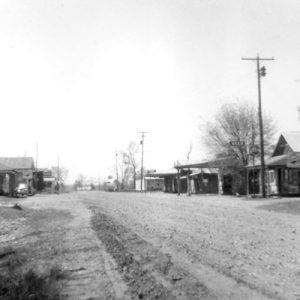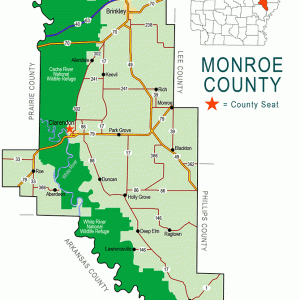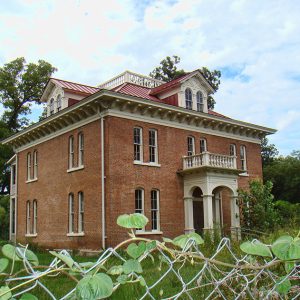calsfoundation@cals.org
Blackton (Monroe County)
Little remains of the town of Blackton, but the area is significant as an important farming region and as the location of two national historic sites.
Blackton is two and a half miles northwest of the intersection of Monroe, Phillips, and Lee counties. This intersection also marks the established beginning point to survey lands of the Louisiana Purchase. The beginning point was designated as a National Historic Landmark in 1993. The site became the location of the Louisiana Purchase Historic State Park.
Also near Blackton was the Palmer House. This grand brick structure built in 1873 by John C. Palmer was on the National Register of Historic Places prior to burning down in 2013. Palmer was a farmer, lawyer, and owner of a Helena (Phillips County) newspaper.
Post Office Department records show how the location of the community moved through the years. A form dated March 18, 1880, for a proposed post office at Hickory Hills has been altered to show the name of the new post office as “Dunn.” But that same form was altered again to show that the name was being changed to Blackton. The department continued to send location request forms to the postmaster at Dunn in 1883 and in 1890. By 1895, the Post Office Department was writing to the postmaster at “Blackton (late Dunn).”
Railroad maps and atlases for 1893 and 1895 indicate that Dunn was just east of the present Blackton. According to oral history, the name change and location shift came about because Major William Black of Brinkley (Monroe County) built a railroad south from Brinkley through the area to transport timber to his sawmill.
The Arkansas secretary of state has documents showing that Blackton’s petition for incorporation was approved on December 16, 1892, but it seems that no town officials were ever elected and incorporation was never effected.
Act 595 of the state legislature created the Blackton Special School District on April 1, 1919. A small frame building was constructed in 1926 to replace an aging building. The school provided education for grades one through twelve until the district consolidated with Holly Grove (Monroe County) in the early 1930s. Only elementary grades were then taught at Blackton until the school closed at the end of the 1952 term. All classes were then moved to Holly Grove. The building was used as a residence but later burned.
Goats graze where stores once stood, and only a few houses remain. But from the 1880s to the early 1950s, Blackton was a center of activity and community support for a population of perhaps nearly a hundred families. Until after World War II, grocery stores, sawmills, a cotton gin, the railroad, dance halls, and beer joints flourished. Migration to California and “up north” that had begun during the Depression sped up during the war, and as farming methods changed, the exodus spelled the end of the town. The post office was discontinued in 1966. By that time, the train depot and the school had long been gone, and by the mid-1970s, all commercial activity was gone; the little white frame church that had stood for nearly 100 years was torn down.
For additional information:
Biographical and Historical Memoirs of Eastern Arkansas. Chicago: Goodspeed Publishing Company, 1890.
Lynch, Hope. “History of Blackton,” Monroe County Citizen. December 4, 1958, p. 9; December 18, 1958, p. 4; December 25, 1958, p. 6.
B. J. Houser
Little Rock, Arkansas
 Blackton School
Blackton School  Blackton Street Scene
Blackton Street Scene  Monroe County Map
Monroe County Map  Palmer House
Palmer House  Union Church
Union Church 




Comments
No comments on this entry yet.